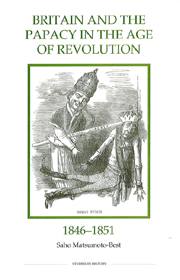Book contents
- Frontmatter
- Contents
- Dedication
- List of illustrations
- Acknowledgements
- Abbreviations
- Introduction
- 1 From 1815 to the election of Pius IX
- 2 The pope's liberal reforms, 1846–1847
- 3 The origins of the Minto mission
- 4 Britain and the 1848 revolution in Rome
- 5 Britain and the rise and fall of the Roman republic
- 6 The restoration of the Catholic hierarchy and anti-Catholicism in Britain
- Conclusion
- Bibliography
- Index
2 - The pope's liberal reforms, 1846–1847
Published online by Cambridge University Press: 12 September 2012
- Frontmatter
- Contents
- Dedication
- List of illustrations
- Acknowledgements
- Abbreviations
- Introduction
- 1 From 1815 to the election of Pius IX
- 2 The pope's liberal reforms, 1846–1847
- 3 The origins of the Minto mission
- 4 Britain and the 1848 revolution in Rome
- 5 Britain and the rise and fall of the Roman republic
- 6 The restoration of the Catholic hierarchy and anti-Catholicism in Britain
- Conclusion
- Bibliography
- Index
Summary
Palmerston's conviction that Pius should receive limited support from Britain was reaffirmed in the year following his election, for the new pope quickly followed the amnesty with other liberal measures, such as the new press law of 15 May 1847 and the establishment of the civic guard on 3 July. In Rome there were public demonstrations of support with cries of ‘Viva Pio Nono’ in the streets. However, the emergence of Pius as a progressive figure not only meant more enlightened government for the Papal States, but also acted as a stimulus to the growth of Italian nationalism and the concomitant development of anti-Austrian sentiment. Thus, even beyond the borders of the Papal States, ‘Papa Angelico’, as he was sometimes called, became a heroic figure. Even in Protestant Britain both the government and public opinion greeted these rapid changes in the situation at Rome with acclaim. The year 1847 therefore saw the unlikely emergence of the leader of the Catholic Church as a symbol of liberalism, nationalism and the struggle against Austrian despotism.
The first reforms
After the amnesty in July 1846 there was high expectation that reforms of the political system in the Papal States would soon follow. However, in order to introduce his reform programme, Pius IX needed somebody capable of assisting him, because the ultra-conservative zelanti still stood as a powerful obstacle. It had initially been expected that Cardinal Lambruschini would be elected secretary of state again, but Pius needed to remove the ultra-conservatives from the Curia and therefore decided to appoint a figure more sympathetic to his own beliefs.
- Type
- Chapter
- Information
- Publisher: Boydell & BrewerPrint publication year: 2003



